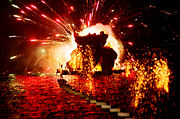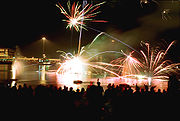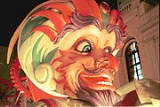
Patras Carnival
Encyclopedia
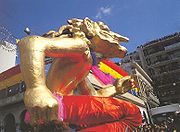
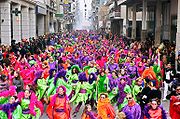
Greece
Greece , officially the Hellenic Republic , and historically Hellas or the Republic of Greece in English, is a country in southeastern Europe....
and one of the biggest in Europe
Europe
Europe is, by convention, one of the world's seven continents. Comprising the westernmost peninsula of Eurasia, Europe is generally 'divided' from Asia to its east by the watershed divides of the Ural and Caucasus Mountains, the Ural River, the Caspian and Black Seas, and the waterways connecting...
. It has more than 160 years of history. The events begin on 17 January and last up to Clean Monday
Clean Monday
Clean Monday , also known as Pure Monday, Ash Monday, Monday of Lent or Green Monday, is the first day of the Eastern Orthodox Christian and Eastern Catholic Great Lent...
. The carnival of Patras
Patras
Patras , ) is Greece's third largest urban area and the regional capital of West Greece, located in northern Peloponnese, 215 kilometers west of Athens...
is not a single event but a variety of events that includes balls, parades, hunting of hidden treasure, kids’ carnival etc. Its apogee is in the last weekend of Carnival with the Saturday evening parade of carnival groups, the extravagant Sunday parade of floats
Float (parade)
A float is a decorated platform, either built on a vehicle or towed behind one, which is a component of many festive parades, such as those of Mardi Gras in New Orleans, the Carnival of Viareggio, the Maltese Carnival, the Macy's Thanksgiving Day Parade, the Key West Fantasy Fest parade, the...
and groups, and finally the ritual burning of king carnival at the St. Nikolaos Street wharf in the harbour of Patras. Its characteristics are spontaneity, improvisation, inspiration and volunteerism.
History
Most people agree that starting event of the Patras Carnival was a ball given in the residence of the merchant Moretis in 1829. However the carnival, as most carnival events in the Mediterranean and the Balkans, is connected with ancient paganPaganism
Paganism is a blanket term, typically used to refer to non-Abrahamic, indigenous polytheistic religious traditions....
rituals, as those to honour Dionysus
Dionysus
Dionysus was the god of the grape harvest, winemaking and wine, of ritual madness and ecstasy in Greek mythology. His name in Linear B tablets shows he was worshipped from c. 1500—1100 BC by Mycenean Greeks: other traces of Dionysian-type cult have been found in ancient Minoan Crete...
. According to these traditions, in the heart of the winter, the faithful invoke the deity with special feasts and he is reborn in order to bring spring once again. In modern period, French troops of general Maison
Nicolas Joseph Maison
Nicolas Joseph Maison, 1er Marquis Maison was a Marshal of France and Minister of War.-French revolution and Napoléon:Maison was born at born in Épinay-sur-Seine, near Paris....
stationed in the city after its liberation from the Turks
Ottoman Empire
The Ottoman EmpireIt was usually referred to as the "Ottoman Empire", the "Turkish Empire", the "Ottoman Caliphate" or more commonly "Turkey" by its contemporaries...
. Later on, and as consequence of the prosperity of the city in the end of 19th century the carnival festivities take a more regular nature. The first carnival floats appeared in the decade of 1870s. Then the floats were exclusively creations of individuals, only later did the Municipality of Patras undertake to construct a large number of them. In the same decade, in 1872, with contributions of rich raisin merchants the celebrated "Apollo" Theatre is built, and it entertains carnival dances, as it does precisely today, because the theatre continues to have a central role in the carnival celebrations. In 1880 on Saint Anthony's
Anthony the Great
Anthony the Great or Antony the Great , , also known as Saint Anthony, Anthony the Abbot, Anthony of Egypt, Anthony of the Desert, Anthony the Anchorite, Abba Antonius , and Father of All Monks, was a Christian saint from Egypt, a prominent leader among the Desert Fathers...
day the first "mpoules" appeared (teams disguised that hang around in the neighborhoods and with humorous disposal joke with friends). This custom tends to disappear nowadays. Besides, as the historian of Patras Carnival Nikos Politis testifies, beautiful carnivals were organized during the belle époque
Belle Époque
The Belle Époque or La Belle Époque was a period in European social history that began during the late 19th century and lasted until World War I. Occurring during the era of the French Third Republic and the German Empire, it was a period characterised by optimism and new technological and medical...
as in the years 1900, 1907, 1909 with the attendance for first time of individuals of each social class and origin. This period also gave birth to the egg-war custom, with wax eggs stuffed with confetti
Confetti
Confetti is a multitude of pieces of paper, mylar or metallic material which is usually thrown at parades and celebrations, especially weddings . Confetti is made in a variety of colors, and commercially available confetti is available in imaginative shapes...
(made with special machines) which the carnivalists threw from the balconies. Although this custom has disappeared today, it is considered to be the precursor of the chocolate war.
The developments of the following decade were not favourable for the carnival; the continuous wars and conflicts (Balkan wars
Balkan Wars
The Balkan Wars were two conflicts that took place in the Balkans in south-eastern Europe in 1912 and 1913.By the early 20th century, Montenegro, Bulgaria, Greece and Serbia, the countries of the Balkan League, had achieved their independence from the Ottoman Empire, but large parts of their ethnic...
, World War I
World War I
World War I , which was predominantly called the World War or the Great War from its occurrence until 1939, and the First World War or World War I thereafter, was a major war centred in Europe that began on 28 July 1914 and lasted until 11 November 1918...
, Asia Minor campaign
Greco-Turkish War (1919-1922)
The Greco–Turkish War of 1919–1922, known as the Western Front of the Turkish War of Independence in Turkey and the Asia Minor Campaign or the Asia Minor Catastrophe in Greece, was a series of military events occurring during the partitioning of the Ottoman Empire after World War I between May...
) send the men in the war front and brought economic crisis and desolation to the city. In the first postwar years the situation does not improve perceptibly, only some scattered events testify the arrival of Carnival. Obvious exception constitute the imposing and amazing carnivals of the years 1938 and 1939. Nevertheless, the World War II
World War II
World War II, or the Second World War , was a global conflict lasting from 1939 to 1945, involving most of the world's nations—including all of the great powers—eventually forming two opposing military alliances: the Allies and the Axis...
and the consecutive Greek Civil War
Greek Civil War
The Greek Civil War was fought from 1946 to 1949 between the Greek governmental army, backed by the United Kingdom and United States, and the Democratic Army of Greece , the military branch of the Greek Communist Party , backed by Bulgaria, Yugoslavia and Albania...
bring a decennial obligatory interruption. In the beginning of the 1950s the first hesitant thoughts for a resurgence of carnival are expressed. The most pessimistic predict a failure: "nothing will be as before". However, the carnival is indeed reborn. The pioneer musical groups "Orpheus" and "Patraiki' Mantolinata" lead the effort. The Patras Carnival returns in the lives of the citizens of Patras but also all Greeks, especially those that could afford (mainly affluent Athenians) to travel in Patras in order to participate in the carnival, as in its famous Bourboulia balls. In the same period the Greek cinema
Cinema of Greece
Greece has a long and rich cinematic history. Greek films dominate the domestic market, for example Safe Sex had more box office receipts than Titanic. Characteristics of Greek cinema include a dynamic plot, strong character development and erotic themes...
depicts snapshots of carnival in its films. Yet more historic scenes can be seen in prewar films. Still in the 1950s, the carnival becomes the object of attacks, as fanatic Christian and other misinformed moralistic organisations roll up to Patras from other regions of Greece during the carnival in order to denounce orgies, corruptness, "Sodom and Gomorrah
Sodom and Gomorrah
Sodom and Gomorrah were cities mentioned in the Book of Genesis and later expounded upon throughout the Hebrew Bible, the New Testament and Deuterocanonical sources....
", but they are prevented from creating trouble by the police. The completely unfounded accusations meet with indifference or a feeling of nuisance by the citizens of Patras and visitors of carnival. It is characteristic that the local church does not sympathise with the troublemakers since it knows that the carnival is a completely innocent recreational event. Yet, in the same period in certain cases censorship
Censorship
thumb|[[Book burning]] following the [[1973 Chilean coup d'état|1973 coup]] that installed the [[Military government of Chile |Pinochet regime]] in Chile...
is imposed in certain carnival creations which upset the establishment with their humour. Finally in 1964 the year of king Paul's
Paul of Greece
Paul reigned as King of Greece from 1947 to 1964.-Family and early life:Paul was born in Athens, the third son of King Constantine I of Greece and his wife, Princess Sophia of Prussia. He was trained as a naval officer....
death the Carnival was cancelled.
Under no circumstances could these limited exceptions shade the magnificence of carnival, which had already known Pan-Hellenic recognition while it also attracted the attention of certain international media. In 1966 the carnival was reorganized. The journalist Nikos Mastorakis introduces the Hidden Treasure Hunt
Treasure hunt (game)
A treasure hunt is one of many different types of games which can have one or more players who try to find hidden articles, locations or places by using a series of clues. This is a fictional activity; treasure hunting can also be a real life activity. Treasure hunt games may be an indoor or...
in which 94 citizens of Patras and visitors with their cars take part. The first prize was won by a team led by a friend of the carnival from Thessalonica; his name was Alkis Steas and he presented the game starting from the following year. Thus, the late Steas became for decades the legendary presenter of the carnival, which was broadcasted by ERT
Elliniki Radiofonia Tileorasi
The Hellenic Broadcasting Corporation is the Greek state-owned public radio and television broadcasting corporation. It is a member of EBU.Since 70's ERT is part of the Eurovision Song Contest, organized by EBU...
and was watched by all Greek TV viewers. The presenter's expressions such as "the Carnival city of Greece", when he referred to Patras and "be happy" and "keep dancing!" when he referred to the carnival groups, remain historical. In 1974 the modern phase of the carnival begins, as the revelers are convinced to abandon their cars and parade on foot in the streets (until then only floats paraded). Since then each year the spectacle climaxes, the carnival has become gigantic and hundreds of thousands of visitors flock to Patras to witness the proceedings. From the early beginning of 2011, Carnival of Patras has its own Web TV channel, broadcasting live and on-demand videos in www.carnivalpatras.tv.
The Opening Ceremony
Irrespectively of when the TriodionTriodion
The Triodion , also called the Lenten Triodion , is the liturgical book used by the Eastern Orthodox and Eastern Catholic Churches of Byzantine rite during Great Lent, the three preparatory weeks leading up to it, and during Holy Week.Many canons in the Triodion contain only three odes or...
falls,the three-week period preceding the first Sunday of Lent, it is customary for the Carnival of Patras on start on the day of St. Anthony (17 January). The opening ceremony takes place on George Square and includes pantomimes and patters, dances, endless music and fireworks.
The Children carnival
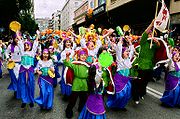
The Saturday night parade
This is also called the "Nihterini Podarati" [Night Parade on foot].In earlier years, only the Treasure Hunt groups could participate, without their floats. However, the last few years every group is free to join. Night, bright lights, an overwhelming stream of people, colors and high spirits combine, create a spectacular scene.Closing Ceremony
